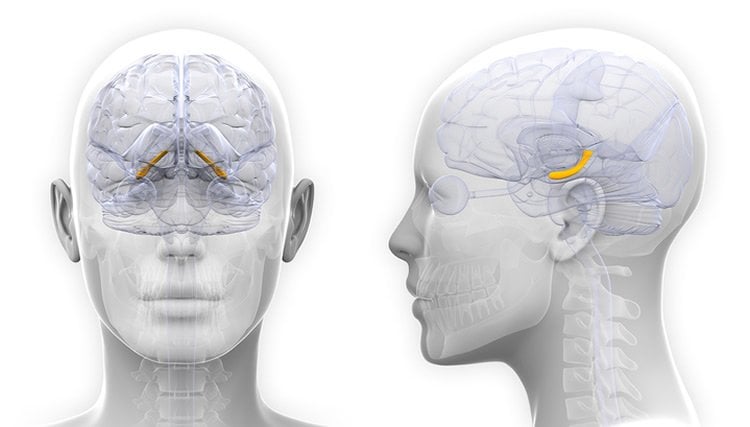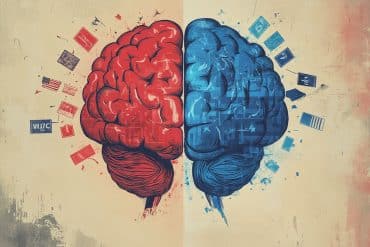Summary: As estrogen levels rise in women, the volume of the hippocampus increases, a new study reports.
Source: Max Planck Institute.
In parallel to rising estrogen levels, the Hippocampus increases in volume.
Although it has already been known for some time that the brain does not remain rigid in its structure even in adulthood, scientists at the Max Planck Institute for Human Cognitive and Brain Sciences made a surprising discovery: The brain is not only able to adapt to changing conditions in long-term processes, but it can do this every month. The researchers observed that in women, in parallel to the rhythm of the level of estrogen across their menstrual cycle, the structures of the Hippocampus vary — a brain area that is crucial for memories, mood and emotions.
Each month, women experience the up and down of hormones during their menstrual cycle. And from month to month these variations appear to not just influence the switching between fertile and infertile days. The fluctuating hormone levels also change the structure of the brain in astonishing regularity, as demonstrated by the results of the study on the hormonal influence on the brain structure at the Max Planck Institute for Human Cognitive and Brain Sciences in Leipzig.
“We found, that in parallel to the rising estrogen levels leading up to ovulation, the Hippocampus also increases in volume—the volume of the grey matter as well as that of the white matter”, explains Claudia Barth, first author of the corresponding paper published in the renowned magazine Nature Scientific Reports. How these fluctuations of the brain structures precisely affect the behaviour and specific cognitive abilities remains a mystery. But the neuroscientists do have a theory: “The Hippocampus plays a crucial role in our memories, our mood, and our emotions. In mice it has already been proven that it is not just this brain structure but also different behaviours which underlie a type of monthly cycle.”

Whether these observations are also valid for humans has to be proven in further studies. After testing the results of this first pilot study on the connection between the level of estrogen and the Hippocampus in a larger group of study participants, the researchers will scrutinise the effects on the behaviour. “If it appears, for instance, that women in certain phases of their cycle are particularly receptive, these women could undergo therapy”, she explains. This could take place at a specific time point when a woman is in a position to do so.”
With these findings, the neuroscientists have laid the foundations for their overall goal: Investigating the relationships of premenstrual dysphoric disorder (PMDD), a disorder which affects one in twelve women in the days leading up to her time of the month. These women complain of severe physical and psychological symptoms such as listlessness or mood swings comparable to a depressive episode. “To get a better understanding of this disorder, we first have to find out which monthly rhythm the brain of a healthy woman follows. Only then can we reveal the differences in persons affected by PMDD”, says Julia Sacher.
Source: Claudia Barth – Max Planck Institute
Image Source: NeuroscienceNews.com image is adapted from the MPG press release.
Original Research: Full open access research for “In-vivo Dynamics of the Human Hippocampus across the Menstrual Cycle” by Sandra-Fausia Soukup, Sabine Kuenen, Roeland Vanhauwaert, Julia Manetsberger, Sergio Hernández-Díaz, Jef Swerts, Nils Schoovaerts, Sven Vilain, Natalia V. Gounko, Katlijn Vints, Ann Geens, Bart De Strooper, and Patrik Verstreken in Scientific Reports. Published online October 7 2016 doi:10.1038/srep32833
[cbtabs][cbtab title=”MLA”]Max Planck Institute “Female Brains Change in Sync With Hormones.” NeuroscienceNews. NeuroscienceNews, 10 October 2016.
<https://neurosciencenews.com/female-estrogen-hippocampus-5249/>.[/cbtab][cbtab title=”APA”]Max Planck Institute (2016, October 10). Female Brains Change in Sync With Hormones. NeuroscienceNew. Retrieved October 10, 2016 from https://neurosciencenews.com/female-estrogen-hippocampus-5249/[/cbtab][cbtab title=”Chicago”]Max Planck Institute “Female Brains Change in Sync With Hormones.” https://neurosciencenews.com/female-estrogen-hippocampus-5249/ (accessed October 10, 2016).[/cbtab][/cbtabs]
Abstract
In-vivo Dynamics of the Human Hippocampus across the Menstrual Cycle
Sex hormones fluctuate during the menstrual cycle. Evidence from animal studies suggests similar subtle fluctuations in hippocampal structure, predominantly linked to estrogen. Hippocampal abnormalities have been observed in several neuropsychiatric pathologies with prominent sexual dimorphism. Yet, the potential impact of subtle sex-hormonal fluctuations on human hippocampal structure in health is unclear. We tested the feasibility of longitudinal neuroimaging in conjunction with rigorous menstrual cycle monitoring to evaluate potential changes in hippocampal microstructure associated with physiological sex-hormonal changes. Thirty longitudinal diffusion weighted imaging scans of a single healthy female subject were acquired across two full menstrual cycles. We calculated hippocampal fractional anisotropy (FA), a measure sensitive to changes in microstructural integrity, and investigated potential correlations with estrogen. We observed a significant positive correlation between FA values and estrogen in the hippocampus bilaterally, revealing a peak in FA closely paralleling ovulation. This exploratory, single-subject study demonstrates the feasibility of a longitudinal DWI scanning protocol across the menstrual cycle and is the first to link subtle endogenous hormonal fluctuations to changes in FA in vivo. In light of recent attempts to neurally phenotype single humans, our findings highlight menstrual cycle monitoring in parallel with highly sampled individual neuroimaging data to address fundamental questions about the dynamics of plasticity in the adult brain.
“In-vivo Dynamics of the Human Hippocampus across the Menstrual Cycle” by Sandra-Fausia Soukup, Sabine Kuenen, Roeland Vanhauwaert, Julia Manetsberger, Sergio Hernández-Díaz, Jef Swerts, Nils Schoovaerts, Sven Vilain, Natalia V. Gounko, Katlijn Vints, Ann Geens, Bart De Strooper, and Patrik Verstreken in Scientific Reports. Published online October 7 2016 doi:10.1038/srep32833







